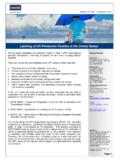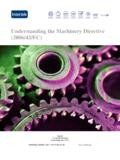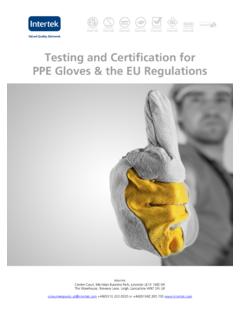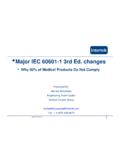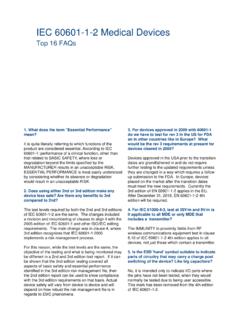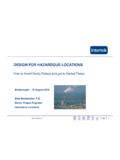Transcription of Electric motors for use in hazardous areas - Intertek
1 Intertek Deeside Lane, Chester, CH1 6DD UK 01244 882590 Explosion protected motors for use in hazardous areas Explosion protected motors for use in hazardous areas 1 Glossary VFD = Variable Frequency Drive VSD = Variable Speed Drive Ex d = Flameproof Ex e = Increased Safety Ex nA = Non-Sparking Ex p (x/y/z) = Purged/Pressurized Introduction The use of motors within industrial applications is not new, and is one of the simplest means of converting electrical energy into kinetic energy to perform a task in applications from household washing machines to pharmaceutical mixers, to oil drilling, and much, much more.
2 motors are used not just for rotary applications, but, when used in conjunction with mechanical belts, gears and couplings are used for linear, eccentric and all manner of physical motion that may be required. These mechanical devices do themselves require consideration for their explosion protection properties, but will be dealt with separately in an article dedicated to non-electrical equipment protection methods. Selection of motor for use in the hazardous area Along with the parameters of the application in which the motor is to be used ( speed, kW, frame size, etc), the user must consider the explosion protection methods applied to the motor and the hazardous area into which the motor will be mounted.
3 Here is a brief outline of the protection concepts that can be applied to Electric motors , where the can be used and the classification and markings required to show where they can be used. Explosion protected motors for use in hazardous areas 2 Protection Concepts Type of protection Symbol Typical IEC EPL Typical zones IEC Standard Basic concept of protection Optical Radiation Op pr Op sh Op is Gb Ga Ga 1,2 0,1,2 0,1,2 IEC 60079-28 IEC 60079-28 IEC 60079-28 Inherently safe protected by shutdown Increased safety Type n non-sparking e nA Gb Gc 1,2 2 IEC 60079-7 IEC 60079-15 No arcs, sparks or hot surfaces. Enclosure IP 54 or better Flameproof Type n (enclosed break) d nC Gb Gc 1,2 2 IEC 60079-1 IEC 60079-15 Contain the explosion, quench the flame Quartz/sand filled q Gb 1,2 IEC 60079-5 Quench the flame Intrinsic safety Intrinsic safety Intrinsic safety ia ib ic Ga Gb Gc 0,1,2 1,2 2 IEC 60079-11 IEC 60079-11 IEC 60079-11 Limit the energy of sparks and surface temperatures Pressurised (up to 2007) Pressurised Pressurised Pressurised Type n (sealing and hermetic sealing) Type n (restricted breathing)
4 Encapsulation Encapsulation Encapsulation Oil immersion p px py pz nC nR ma mb mc o Gb Gb Gb Gc Gc Gc Ga Gb Gc Gb 1,2 1,2 1,2 2 2 2 0,1,2 1,2 2 1,2 IEC 60079-2 IEC 60079-2 IEC 60079-2 IEC 60079-2 IEC 60079-15 IEC 60079-15 IEC 60079-18 IEC 60079-18 IEC 60079-18 IEC 60079-6 Keep the flammable gas out Enclosure tD Da 20,21,22 IEC 60079-31 Standard protection for dusts, rugged tight enclosure Intrinsic safety iD Da 21,22 IEC 61241-11 Similar to tD, but with some relaxations if circuit inside is intrinsically safe Encapsulation mD Dc 22 IEC 61241-18 Protection by encapsulation of incendive parts Pressurised pD Db Dc 21,22 22 IEC 61241-2 Protection by pressurization of enclosure Explosion protected motors for use in hazardous areas 3 Note also that a motor may show multiple markings, such as Ex de IIC T3, this indicates that there have been multiple concepts of protection applied to the motor, for example the motor may be fundamentally protected by flameproof concept of protection.
5 But may have a terminal box that is protected by increased safety concept of protection. Historically, the concepts of protection will have been marked with the dominant , or most prevalent concept of protection first (in the above example that would be Ex d), but more recently, the IEC60079 series of standards have required that markings are placed in alphabetic order. When selecting the concept of protection, the area in which the motor is to be installed must be considered, and this requires a zone drawing for the area to ensure that the selection of equipment is suitable. ATEX categories vs zones of use Equipment Category ATEX 94/9/EC Zone of use Gas, Vapours and Mist Dust Cat 1 Zone 0, 1 and 2 Zone 20, 21 and 22 Cat 2 Zone 1 and 2 Zone 21 and 22 Cat 3 Zone 2 Zone 22 Groups ATEX and IECEx Group Environment Location Typical substance I Coal Mining Methane (Fire damp) IIA Methane, Propane etc.
6 IIB Ethylene IIC Gases, Vapours and Mists Surface and other locations Hydrogen, Acetylene etc. IIIA Combustible flyings IIIB Non-conductive IIIC Combustible Dusts Surface and other locations Conductive Explosion protected motors for use in hazardous areas 4 Temperature Classification Max. Surface Temperature IEC Group II 450 C T1 300 C T2 200 C T3 135 C T4 100 C T5 85 C T6 Note: For Group I (CENELEC/IEC) applications, electrical apparatus has fixed temperature limits ie., 150 C and 450 C. Use of VSD/VFD with explosion protected motors Whilst it may be prudent economically and practically to select a motor/drive combination that best suits the application and cost parameters, it is not always the case that this combination has been considered as suitable for use in explosive atmospheres.
7 The International Standard, IEC60079-0, requires that motors fed from VSD/VFD are tested with the intended drive at various speeds and loads to ensure that the combination does not produce any effects that may invalidate the explosion protection afforded the motor. The drive will, invariably, have to be mounted outside the zoned area (unless it has been tested and assessed to prove its own explosion protection properties, installed within an enclosure with a certified purge controller and then tested and proven to be Ex p (either Ex px, py or pz, in accordance with IEC60079-2)), and feed to the motor in the hazardous area.
8 VFD are known to cause heating in motors due to the harmonic content of their current waveform, and whilst these harmonics provide negligible useful torque at the output shaft, they do cause significant heating effects within the motor windings, and when this is coupled to the use of the VFD to control speed, it becomes clear that the traditional method of testing at maximum speed is not necessarily the point at which the worst case heating effects can be witnessed (and hence the need to test and different speeds and loads within the motor/drive range). Explosion protected motors for use in hazardous areas 5 The type of VFD, duty, and application will all contribute to the test programme, as these will all affect the thermal characteristics of the motor.
9 For example, the VFD may be a PWM (Pulse Width Modulation) drive, or a CSI (Current Source Input) drive or one of many other slightly different technologies available, and each will cause heating in different ways. Also, whether the motor/drive is needed for constant speed, constant torque or constant power will also affect the test programme. Typically, if a PWM inverter is used, and the torque is to remain constant, then running at higher speeds will give a less onerous condition due to the cooling effects of the motor when running at higher speeds, whereas when running at lower speeds and constant torque, the motor will generally run hotter due to the lesser air flow across the windings.
10 The frequency at which the drive operates will also cause a voltage to be induced in the shaft of the motor (assuming it to be an ac induction machine) that will seek a return path. The frequency of this shaft voltage may cause damage to motor bearings due to the return path travelling from the rotor shaft then through the bearings and to the case of the motor. As the circuit is made from shaft to bearing sleeve, to bearing, to sleeve, to case, a spark may be induced and cause pitting on the bearing and sleeve interfaces. As the pitting then rolls and makes further irregular contact between these mating faces, so more sparks are induced until such a point as a regular fluted pattern is left on the bearing sleeve faces.


